Nonimmigrants vs Haitian Community Comparison
COMPARE
Nonimmigrants
Haitian
Social Comparison
Social Comparison
Nonimmigrants
Haitians
3,083
SOCIAL INDEX
28.4/ 100
SOCIAL RATING
234th/ 347
SOCIAL RANK
1,345
SOCIAL INDEX
11.0/ 100
SOCIAL RATING
314th/ 347
SOCIAL RANK
Haitian Integration in Nonimmigrants Communities
The statistical analysis conducted on geographies consisting of 287,568,471 people shows a poor negative correlation between the proportion of Haitians within Nonimmigrant communities in the United States with a correlation coefficient (R) of -0.187. On average, for every 1% (one percent) increase in Nonimmigrants within a typical geography, there is a decrease of 0.010% in Haitians. To illustrate, in a geography comprising of 100,000 individuals, a rise of 1,000 Nonimmigrants corresponds to a decrease of 10.5 Haitians.
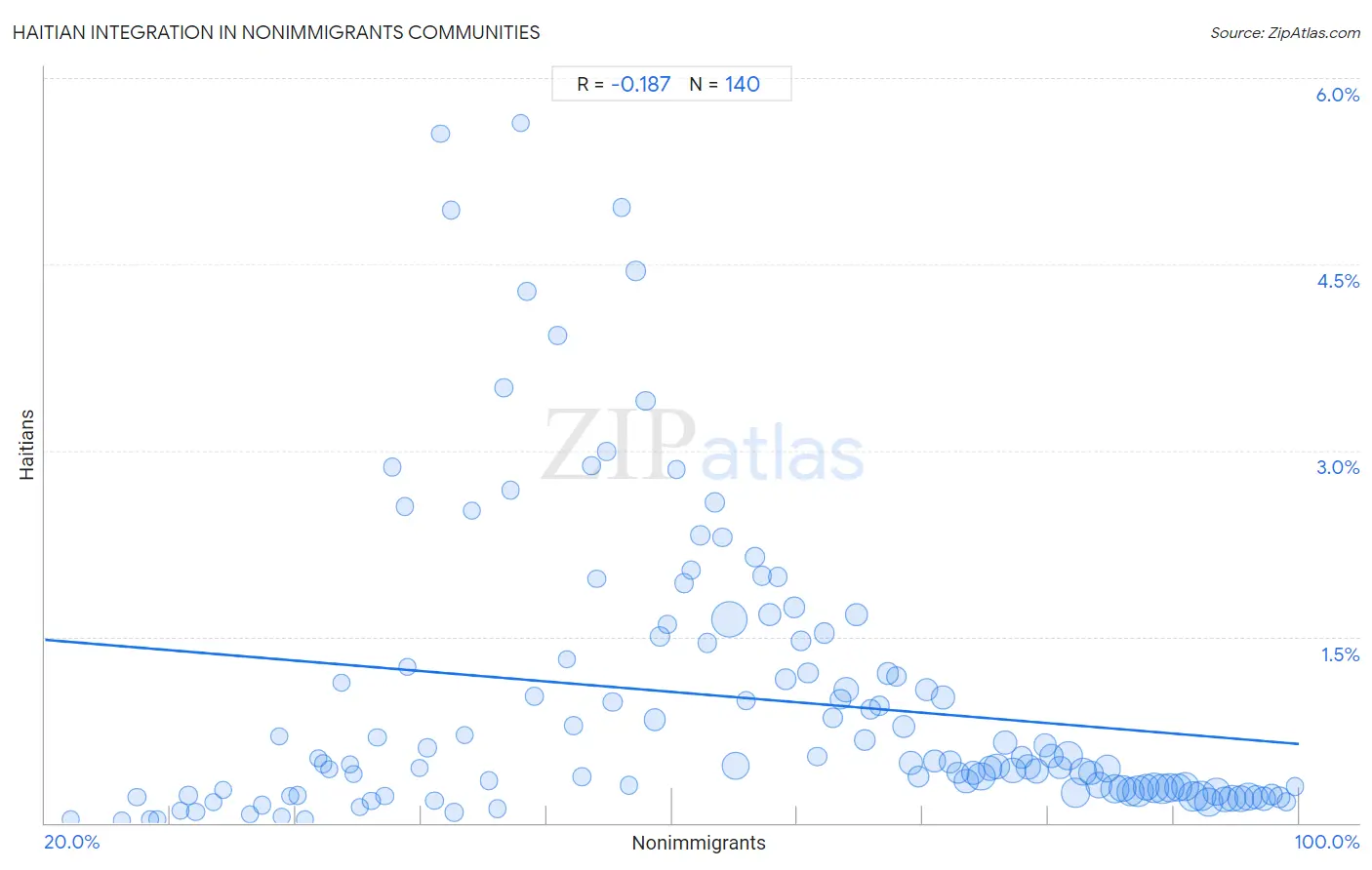
Nonimmigrants vs Haitian Income
When considering income, the most significant differences between Nonimmigrants and Haitian communities in the United States are seen in wage/income gap (27.2% compared to 19.7%, a difference of 37.7%), median male earnings ($52,170 compared to $45,903, a difference of 13.7%), and median family income ($96,231 compared to $85,218, a difference of 12.9%). Conversely, both communities are more comparable in terms of median female earnings ($37,024 compared to $36,374, a difference of 1.8%), householder income under 25 years ($49,348 compared to $50,231, a difference of 1.8%), and median earnings ($44,117 compared to $40,918, a difference of 7.8%).

| Income Metric | Nonimmigrants | Haitian |
| Per Capita Income | Tragic $40,669 | Tragic $37,289 |
| Median Family Income | Tragic $96,231 | Tragic $85,218 |
| Median Household Income | Tragic $79,429 | Tragic $73,306 |
| Median Earnings | Tragic $44,117 | Tragic $40,918 |
| Median Male Earnings | Tragic $52,170 | Tragic $45,903 |
| Median Female Earnings | Tragic $37,024 | Tragic $36,374 |
| Householder Age | Under 25 years | Tragic $49,348 | Tragic $50,231 |
| Householder Age | 25 - 44 years | Tragic $88,301 | Tragic $80,055 |
| Householder Age | 45 - 64 years | Tragic $94,448 | Tragic $84,384 |
| Householder Age | Over 65 years | Tragic $57,426 | Tragic $51,912 |
| Wage/Income Gap | Tragic 27.2% | Exceptional 19.7% |
Nonimmigrants vs Haitian Poverty
When considering poverty, the most significant differences between Nonimmigrants and Haitian communities in the United States are seen in receiving food stamps (12.4% compared to 17.8%, a difference of 43.7%), seniors poverty over the age of 75 (12.2% compared to 16.2%, a difference of 33.0%), and seniors poverty over the age of 65 (10.9% compared to 14.5%, a difference of 32.9%). Conversely, both communities are more comparable in terms of female poverty among 25-34 year olds (15.6% compared to 15.0%, a difference of 4.0%), child poverty under the age of 5 (19.7% compared to 21.2%, a difference of 7.4%), and single mother poverty (32.2% compared to 29.8%, a difference of 7.9%).
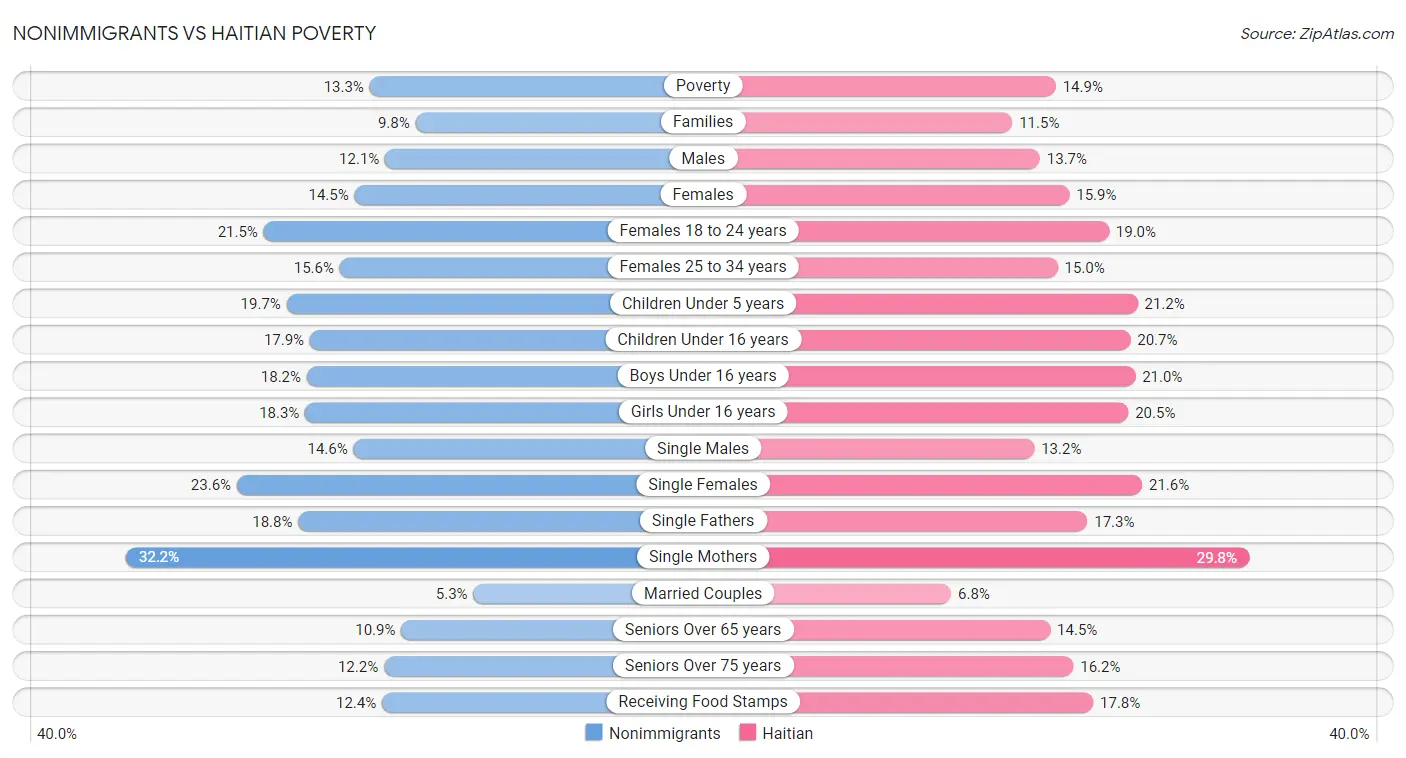
| Poverty Metric | Nonimmigrants | Haitian |
| Poverty | Tragic 13.3% | Tragic 14.9% |
| Families | Tragic 9.8% | Tragic 11.5% |
| Males | Tragic 12.1% | Tragic 13.7% |
| Females | Tragic 14.5% | Tragic 15.9% |
| Females 18 to 24 years | Tragic 21.5% | Exceptional 19.0% |
| Females 25 to 34 years | Tragic 15.6% | Tragic 15.0% |
| Children Under 5 years | Tragic 19.7% | Tragic 21.2% |
| Children Under 16 years | Tragic 17.9% | Tragic 20.7% |
| Boys Under 16 years | Tragic 18.2% | Tragic 21.0% |
| Girls Under 16 years | Tragic 18.3% | Tragic 20.5% |
| Single Males | Tragic 14.6% | Tragic 13.2% |
| Single Females | Tragic 23.6% | Poor 21.6% |
| Single Fathers | Tragic 18.8% | Tragic 17.3% |
| Single Mothers | Tragic 32.2% | Poor 29.8% |
| Married Couples | Fair 5.3% | Tragic 6.8% |
| Seniors Over 65 years | Average 10.9% | Tragic 14.5% |
| Seniors Over 75 years | Average 12.2% | Tragic 16.2% |
| Receiving Food Stamps | Poor 12.4% | Tragic 17.8% |
Nonimmigrants vs Haitian Unemployment
When considering unemployment, the most significant differences between Nonimmigrants and Haitian communities in the United States are seen in unemployment (5.3% compared to 6.2%, a difference of 18.4%), male unemployment (5.4% compared to 6.4%, a difference of 18.3%), and unemployment among youth under 25 years (11.9% compared to 13.9%, a difference of 16.3%). Conversely, both communities are more comparable in terms of unemployment among women with children ages 6 to 17 years (10.0% compared to 10.0%, a difference of 0.10%), unemployment among ages 55 to 59 years (4.9% compared to 4.9%, a difference of 0.56%), and unemployment among ages 30 to 34 years (6.1% compared to 6.1%, a difference of 1.3%).
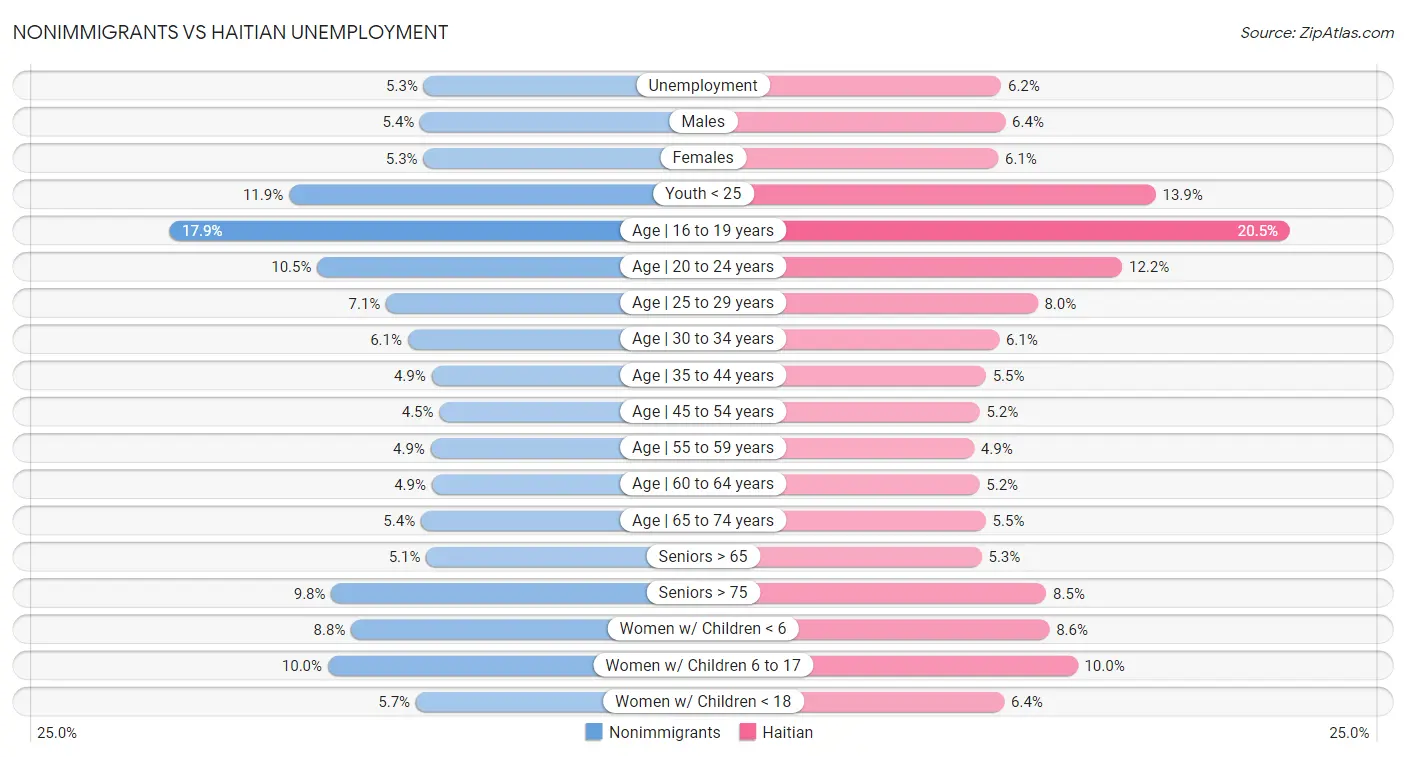
| Unemployment Metric | Nonimmigrants | Haitian |
| Unemployment | Average 5.3% | Tragic 6.2% |
| Males | Poor 5.4% | Tragic 6.4% |
| Females | Average 5.3% | Tragic 6.1% |
| Youth < 25 | Tragic 11.9% | Tragic 13.9% |
| Age | 16 to 19 years | Fair 17.9% | Tragic 20.5% |
| Age | 20 to 24 years | Tragic 10.5% | Tragic 12.2% |
| Age | 25 to 29 years | Tragic 7.1% | Tragic 8.0% |
| Age | 30 to 34 years | Tragic 6.1% | Tragic 6.1% |
| Age | 35 to 44 years | Tragic 4.9% | Tragic 5.5% |
| Age | 45 to 54 years | Good 4.5% | Tragic 5.2% |
| Age | 55 to 59 years | Poor 4.9% | Poor 4.9% |
| Age | 60 to 64 years | Average 4.9% | Tragic 5.2% |
| Age | 65 to 74 years | Fair 5.4% | Tragic 5.5% |
| Seniors > 65 | Average 5.1% | Tragic 5.3% |
| Seniors > 75 | Tragic 9.8% | Exceptional 8.5% |
| Women w/ Children < 6 | Tragic 8.8% | Tragic 8.6% |
| Women w/ Children 6 to 17 | Tragic 10.0% | Tragic 10.0% |
| Women w/ Children < 18 | Poor 5.7% | Tragic 6.4% |
Nonimmigrants vs Haitian Labor Participation
When considering labor participation, the most significant differences between Nonimmigrants and Haitian communities in the United States are seen in in labor force | age 16-19 (40.1% compared to 33.4%, a difference of 20.0%), in labor force | age 20-24 (76.2% compared to 73.6%, a difference of 3.6%), and in labor force | age > 16 (63.5% compared to 65.0%, a difference of 2.3%). Conversely, both communities are more comparable in terms of in labor force | age 25-29 (83.7% compared to 83.7%, a difference of 0.070%), in labor force | age 30-34 (83.5% compared to 84.1%, a difference of 0.66%), and in labor force | age 20-64 (78.1% compared to 79.3%, a difference of 1.6%).

| Labor Participation Metric | Nonimmigrants | Haitian |
| In Labor Force | Age > 16 | Tragic 63.5% | Fair 65.0% |
| In Labor Force | Age 20-64 | Tragic 78.1% | Poor 79.3% |
| In Labor Force | Age 16-19 | Exceptional 40.1% | Tragic 33.4% |
| In Labor Force | Age 20-24 | Exceptional 76.2% | Tragic 73.6% |
| In Labor Force | Age 25-29 | Tragic 83.7% | Tragic 83.7% |
| In Labor Force | Age 30-34 | Tragic 83.5% | Tragic 84.1% |
| In Labor Force | Age 35-44 | Tragic 83.2% | Exceptional 84.8% |
| In Labor Force | Age 45-54 | Tragic 81.2% | Good 82.8% |
Nonimmigrants vs Haitian Family Structure
When considering family structure, the most significant differences between Nonimmigrants and Haitian communities in the United States are seen in single mother households (6.7% compared to 8.3%, a difference of 24.6%), married-couple households (46.9% compared to 41.2%, a difference of 13.9%), and currently married (46.9% compared to 41.3%, a difference of 13.7%). Conversely, both communities are more comparable in terms of family households (64.8% compared to 65.2%, a difference of 0.58%), family households with children (27.5% compared to 27.2%, a difference of 1.0%), and divorced or separated (12.8% compared to 13.3%, a difference of 4.7%).

| Family Structure Metric | Nonimmigrants | Haitian |
| Family Households | Exceptional 64.8% | Exceptional 65.2% |
| Family Households with Children | Good 27.5% | Poor 27.2% |
| Married-couple Households | Good 46.9% | Tragic 41.2% |
| Average Family Size | Tragic 3.19 | Exceptional 3.37 |
| Single Father Households | Tragic 2.4% | Tragic 2.6% |
| Single Mother Households | Poor 6.7% | Tragic 8.3% |
| Currently Married | Good 46.9% | Tragic 41.3% |
| Divorced or Separated | Tragic 12.8% | Tragic 13.3% |
| Births to Unmarried Women | Tragic 35.5% | Tragic 38.6% |
Nonimmigrants vs Haitian Vehicle Availability
When considering vehicle availability, the most significant differences between Nonimmigrants and Haitian communities in the United States are seen in no vehicles in household (7.9% compared to 14.9%, a difference of 88.9%), 4 or more vehicles in household (7.2% compared to 4.6%, a difference of 57.0%), and 3 or more vehicles in household (21.8% compared to 15.5%, a difference of 40.7%). Conversely, both communities are more comparable in terms of 1 or more vehicles in household (92.2% compared to 88.1%, a difference of 4.7%), 2 or more vehicles in household (58.8% compared to 47.6%, a difference of 23.5%), and 3 or more vehicles in household (21.8% compared to 15.5%, a difference of 40.7%).

| Vehicle Availability Metric | Nonimmigrants | Haitian |
| No Vehicles Available | Exceptional 7.9% | Tragic 14.9% |
| 1+ Vehicles Available | Exceptional 92.2% | Tragic 88.1% |
| 2+ Vehicles Available | Exceptional 58.8% | Tragic 47.6% |
| 3+ Vehicles Available | Exceptional 21.8% | Tragic 15.5% |
| 4+ Vehicles Available | Exceptional 7.2% | Tragic 4.6% |
Nonimmigrants vs Haitian Education Level
When considering education level, the most significant differences between Nonimmigrants and Haitian communities in the United States are seen in no schooling completed (1.8% compared to 2.9%, a difference of 58.8%), doctorate degree (1.7% compared to 1.3%, a difference of 28.7%), and professional degree (3.9% compared to 3.5%, a difference of 12.1%). Conversely, both communities are more comparable in terms of nursery school (98.3% compared to 97.2%, a difference of 1.1%), kindergarten (98.3% compared to 97.1%, a difference of 1.2%), and 1st grade (98.2% compared to 97.1%, a difference of 1.2%).
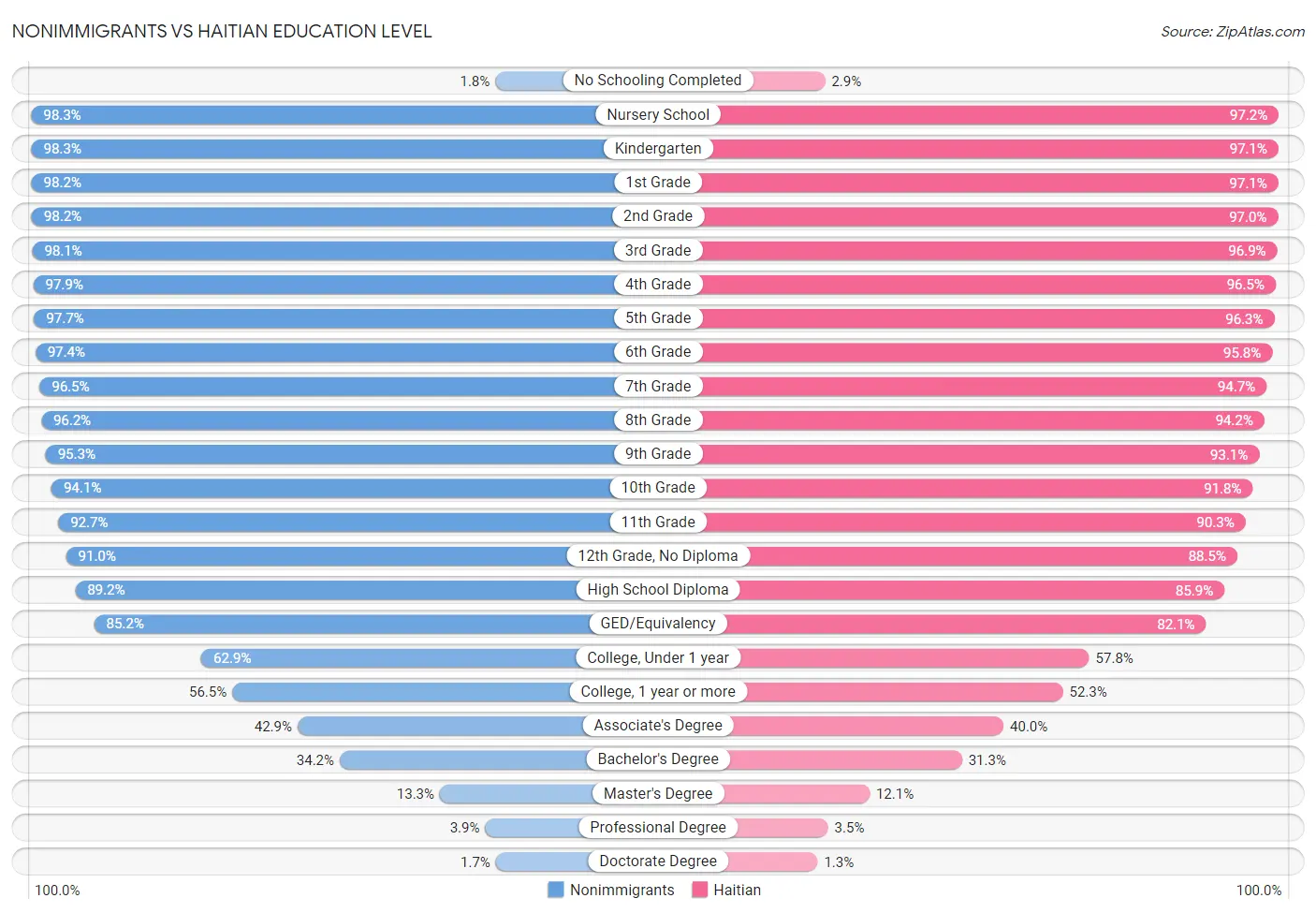
| Education Level Metric | Nonimmigrants | Haitian |
| No Schooling Completed | Exceptional 1.8% | Tragic 2.9% |
| Nursery School | Exceptional 98.3% | Tragic 97.2% |
| Kindergarten | Exceptional 98.3% | Tragic 97.1% |
| 1st Grade | Exceptional 98.2% | Tragic 97.1% |
| 2nd Grade | Exceptional 98.2% | Tragic 97.0% |
| 3rd Grade | Exceptional 98.1% | Tragic 96.9% |
| 4th Grade | Exceptional 97.9% | Tragic 96.5% |
| 5th Grade | Exceptional 97.7% | Tragic 96.3% |
| 6th Grade | Exceptional 97.4% | Tragic 95.8% |
| 7th Grade | Exceptional 96.5% | Tragic 94.7% |
| 8th Grade | Exceptional 96.2% | Tragic 94.2% |
| 9th Grade | Exceptional 95.3% | Tragic 93.1% |
| 10th Grade | Excellent 94.1% | Tragic 91.8% |
| 11th Grade | Good 92.7% | Tragic 90.3% |
| 12th Grade, No Diploma | Fair 91.0% | Tragic 88.5% |
| High School Diploma | Average 89.2% | Tragic 85.9% |
| GED/Equivalency | Fair 85.2% | Tragic 82.1% |
| College, Under 1 year | Tragic 62.9% | Tragic 57.8% |
| College, 1 year or more | Tragic 56.5% | Tragic 52.3% |
| Associate's Degree | Tragic 42.9% | Tragic 40.0% |
| Bachelor's Degree | Tragic 34.2% | Tragic 31.3% |
| Master's Degree | Tragic 13.3% | Tragic 12.1% |
| Professional Degree | Tragic 3.9% | Tragic 3.5% |
| Doctorate Degree | Tragic 1.7% | Tragic 1.3% |
Nonimmigrants vs Haitian Disability
When considering disability, the most significant differences between Nonimmigrants and Haitian communities in the United States are seen in hearing disability (3.6% compared to 2.6%, a difference of 36.3%), disability age under 5 (1.6% compared to 1.3%, a difference of 28.3%), and disability age 18 to 34 (7.6% compared to 6.0%, a difference of 26.5%). Conversely, both communities are more comparable in terms of self-care disability (2.6% compared to 2.6%, a difference of 0.33%), cognitive disability (17.4% compared to 17.5%, a difference of 0.59%), and disability age over 75 (48.0% compared to 47.4%, a difference of 1.4%).
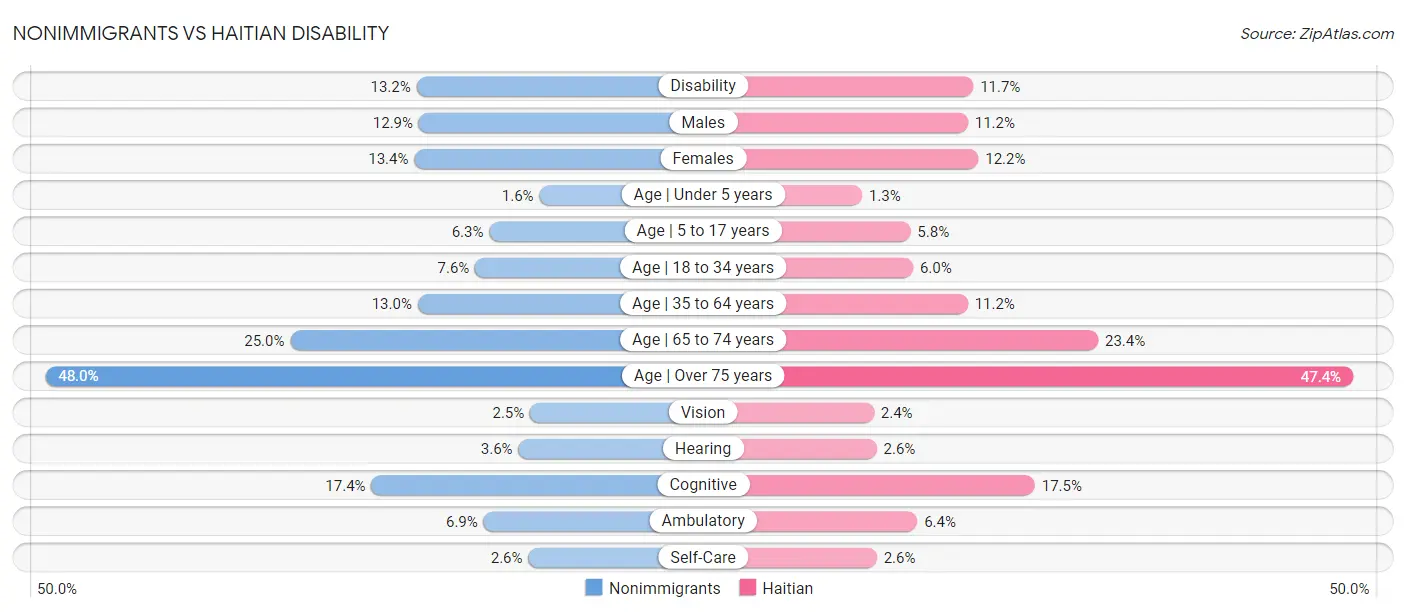
| Disability Metric | Nonimmigrants | Haitian |
| Disability | Tragic 13.2% | Average 11.7% |
| Males | Tragic 12.9% | Average 11.2% |
| Females | Tragic 13.4% | Average 12.2% |
| Age | Under 5 years | Tragic 1.6% | Fair 1.3% |
| Age | 5 to 17 years | Tragic 6.3% | Tragic 5.8% |
| Age | 18 to 34 years | Tragic 7.6% | Exceptional 6.0% |
| Age | 35 to 64 years | Tragic 13.0% | Average 11.2% |
| Age | 65 to 74 years | Tragic 25.0% | Average 23.4% |
| Age | Over 75 years | Tragic 48.0% | Average 47.4% |
| Vision | Tragic 2.5% | Tragic 2.4% |
| Hearing | Tragic 3.6% | Exceptional 2.6% |
| Cognitive | Fair 17.4% | Poor 17.5% |
| Ambulatory | Tragic 6.9% | Tragic 6.4% |
| Self-Care | Tragic 2.6% | Tragic 2.6% |